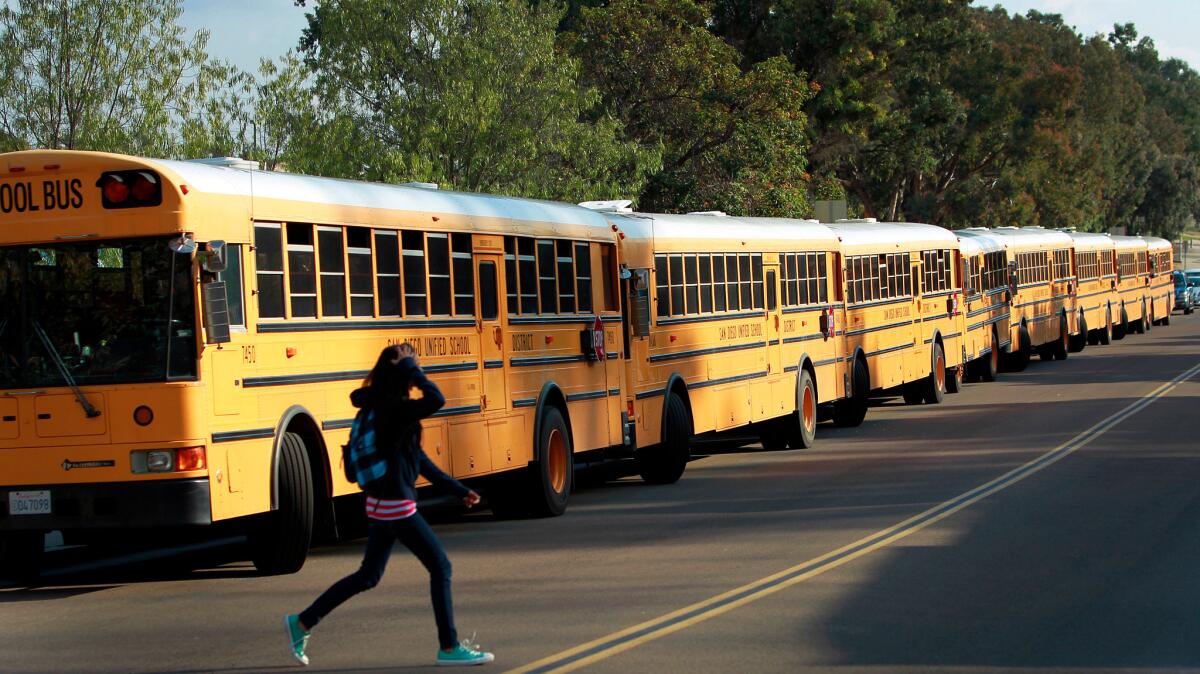Classes started this morning for the Los Angeles Unified School District, the nation’s second-largest school system.
With school back in session, the district faced many questions: What will Supt. Michelle King do during her first school year? Will the district be able to recoup enrollment as charter schools grow? Are lunches tasting better? Will students get their schedules on time? Will the district’s graduation rate continue to go up?
Our reporters took you behind the scenes at the district’s newest schools, including a magnet school for firefighters. We checked in with officials, including King and Mayor Eric Garcetti, who wanted to show off the district’s best features on the first day. Throughout the school year, we plan to keep an eye on what’s working and what isn’t.
You can participate in our coverage year-round by talking to us on Facebook and Twitter, and sending us tips at [email protected]. What do you want to know about your school district? How can we help you?
- Share via
See you in class!
- Share via
It’s hot outside -- and inside some schools
As students returned to school Tuesday, the sun beat down on them, with temperatures reaching 89 degrees in downtown Los Angeles.
But not all schools had working air conditioners to help them stay cool enough to focus on their lessons.
According to Elvia Perez Cano, a spokesperson for the Los Angeles Unified School District, there were 1,176 open service calls to repair or update air conditioning across the district. That’s out of 30,000 classrooms total.
As of 2:54 p.m., the district had received 321 service calls on the first day back.
The district’s Maintenance and Operations team has been replacing air conditioning units, Perez Cano said — an operation that has cost over $300 million in recent years. At the end of each school year, that team surveys all HVAC units, and plant managers place service calls for those that don’t work.
There are 160 portable air conditioning units available to distribute between the schools, and technicians will be working overtime, she said.
This isn’t a new problem. Last year, during a heat wave, there were 2,600 backlogged calls — and the district received 346 air conditioner complaints in one day.
The heat can make it harder to focus in class.
This week’s highs could reach 86 degrees downtown, and 94 in parts of the Valley, according to the Weather Channel.
- Share via
Using the ABCs to address bullying
One recurring back-to-school concern parents have shared on our Facebook page is bullying.
L.A. Unified does have a bullying and hazing policy, which was updated in fall 2014. The policy defines bullying as “any deliberate and unwanted severe of pervasive physical, verbal or electronic act” that is either intended to or could be predicted to create a reasonable fear of harm; detrimental effect on health; or interfere with academic performance or school participation.
Policies are important. But the reality is they don’t always stop bullying.
Kaiser Permanente has a few anti-bullying ideas that we’ve condensed into ABCs:
A – Acknowledge the behavior. Ignoring it will not make it go away. This is also a way to affirm for your child that you are there to support them, even if you don’t have an immediate solution.
B – Be prepared. Role-playing can give children a chance to prepare and practice responses so that they come naturally, whether it is being assertive or using humor.
C – Communicate with teachers and school leaders to come up with a coordinated plan to address the issue.
Another idea, according to The National PTA, is encouraging empathy.
To model empathy, parents can highlight everyday situations and encourage children to see them from different perspectives. An example: “Gabrielle is new to your school. Do you remember how your first day felt?”
- Share via
When your baby brother heads off to kindergarten
As a recent graduate of Fairfax High School, I was very excited to accompany my brother on his first day of kindergarten. Abram, 5, is attending the same elementary school that I once attended.
Since it was the first day of school, parents and older siblings were allowed to accompany the incoming kindergartners to their classroom to meet and hear from the teacher about her expectations for the students and parents.
As students entered and sat on their desks, I realized that the class size was a bit large for kindergarten. Each desk had a small container with about 7 crayons that would be shared by two students.
Students were then told to sit on the carpet and the teacher began to explain the rules and expectations.
One of the things that caught my attention was when she talked about their scarce resources. The teacher went on to explain that, due to the school’s low budget, the students will have to share a lot of material. She then said that she would send a list of materials that parents could donate to the class. After the teacher finished explaining this, she asked the adults to say goodbye to the kids -- and of course that’s when all the kids began to cry.
Miriam Antonio graduated from Fairfax High School last year. An intern at the California Secretary of State’s office, she heads to Santa Monica College later this month.
- Share via
Not all firefighter school students actually want to be firefighters
Genesis Williams wants to be a forensic scientist. Melvin Monroy wants to be an engineer or a football player. Isaiah Sanchez wants to play baseball or be an architect.
But all three students are freshmen in the new Wilson High School Firefighter Academy Magnet.
Most students in the magnet live in El Sereno. Genesis wanted to be in Wilson’s law and justice-themed magnet on the campus, but it was full, she said.
Isaiah, 13, who came to Wilson from the Arroyo Seco Museum Science Magnet, said he wanted to attend a magnet instead of a regular neighborhood school, and wanted to attend one of Wilson’s three magnets because most of his family members were schooled on the campus as well.
“I’m used to the magnet program already,” Isaiah said.
Keith Abrahams, head of the Los Angeles Unified School District’s magnet programs, said he doesn’t mind if they all don’t become firefighters.
They will learn leadership skills that will be useful in any field, he said. Abrahams watched on Tuesday as Los Angeles Fire Department Capt. Eddie Marez taught the students basic military discipline commands in their career exploration class, a mandatory elective.
“It doesn’t matter what field” they go into, Abrahams said. “The goal is just to make sure they’re college and career ready.”
But one goal is to increase recruitment of young, diverse firefighter candidates, said Marez. He says his job over the next four years is to prepare the students for a career in firefighting, and convince as many as possible that it’s the right one for them.
On Tuesday, the 18 students in the career exploration class were mostly Latino. Five were girls. There are 28 students enrolled in the magnet, said magnet coordinator Maribel Gonzalez. They weren’t all in the mandatory class Tuesday because some have schedule conflicts that she plans to sort out by the end of the week, Gonzalez said, while others may have been absent enrolled in a different school.
Marez started on Tuesday by driving into campus in a fire engine, and spending about five minutes of class time showing the students the different elements of the truck: hoses, wooden drawers full of tools, medical supplies.
- Share via
A postscript on back-to-school traffic
Remember when we told you about the gridlock that is back-to-school traffic?
Because we like to be thorough, we wanted to know if there was a way to quantify the effects on your commute during L.A. Unified’s first day back.
Turns out, it’s not something the Los Angeles Department of Transportation has concrete information on.
“We don’t track that,” said LADOT spokesman Bruce Gillman.
But.....
“Anecdotally, yes, I felt it,” Gillman said. “I take surface streets, and my commute today was four to five minutes longer than usual.”
- Share via
What’s for lunch? Some super-easy ideas to make at home
For many of us parents, there’s little more daunting than packing school lunches – every weekday for an entire school year. The anxiety builds with each week: What do you pack? What if your kid gets bored? Can it be nutritious and delicious at the same time? What even constitutes lunch?
We tapped the expertise of our Test Kitchen manager, Noelle Carter, to find a few ideas to mix things up a bit. They range from the easy-to-master standard fare to the slightly ambitious and creative.
We’d love to hear your lunch ideas as well. Tweet me your lunchbox tips and tricks at @mmaltaisLA.

First, old faithful.
PB&J: There’s a reason this is a classic. If peanut butter is not your thing, try another nut butter, such as almond or cashew – or a non-nut butter for those nut-free kids and schools.
Noelle offers an “extra credit” option: You could also have your kids help you make homemade nut butter. She says jams are just as simple and recipes are readily available – or you could always go with a store-bought option.
A regular sandwich can turn magical when you cut it into interesting shapes using cookie cutters, like in the photo above. (We’ve gone with the Millennium Falcon and TIE Fighters in our homemade lunches.)

Wraps: Keep a package of tortillas or flatbread on hand, along with an assortment of deli meats and cheeses. Layer them in the tortilla, along with tomatoes and lettuce or other greens (spinach! kale!), along with some mayonnaise or mustard.
Gluten-free? Forget the tortilla and wrap everything in lettuce.
As another option, you can make a peanut butter (or other butter) wrap with mini chocolate chips, and you’ve got a healthful alternative for dessert.
Onigiri: Have you seen all the creative photos of onigiri on Pinterest? Before you get nervous, it’s really not much more than rice molded into shapes. Noelle suggests using cookie cutters to mold the rice into cute little bears or other shapes. Add bits of vegetable — peas, carrots, etc. — for flavor and then top with sesame seeds and nori sushi wrap.
Skewers: Who doesn’t love food on a stick? Skewer cubes of cheese and leftover roast or chicken, or roll and skewer slices of deli meat. Add tomatoes and veggies, such as carrots, broccoli and cauliflower. It also works with fruit and dessert nibbles.
Helpful hint: If your kids are too young or the school doesn’t allow sharp skewers, popsicle sticks or coffee stirrers are a creative alternative.
And for a little extra credit...
Calzones: Just like empanadas or hand pies but using pizza dough. Sure, you can mix the pizza dough from scratch if you’ve got the time, but there’s also ready-made versions in the refrigerated section. Slather the dough with pasta sauce and add meatballs (homemade or frozen) or other meats or vegetables and top with cheese, then fold over the dough and seal. The calzones bake in about 20 minutes in a 400-degree oven. Pack a little extra pasta sauce on the side for dipping.
For more about homemade dips, soups, salads and quesadillas that are lunch-ready, check out more of Noelle Carter’s tips.
- Share via
All packed up and set to go
- Share via
Promises of free community college, library cards
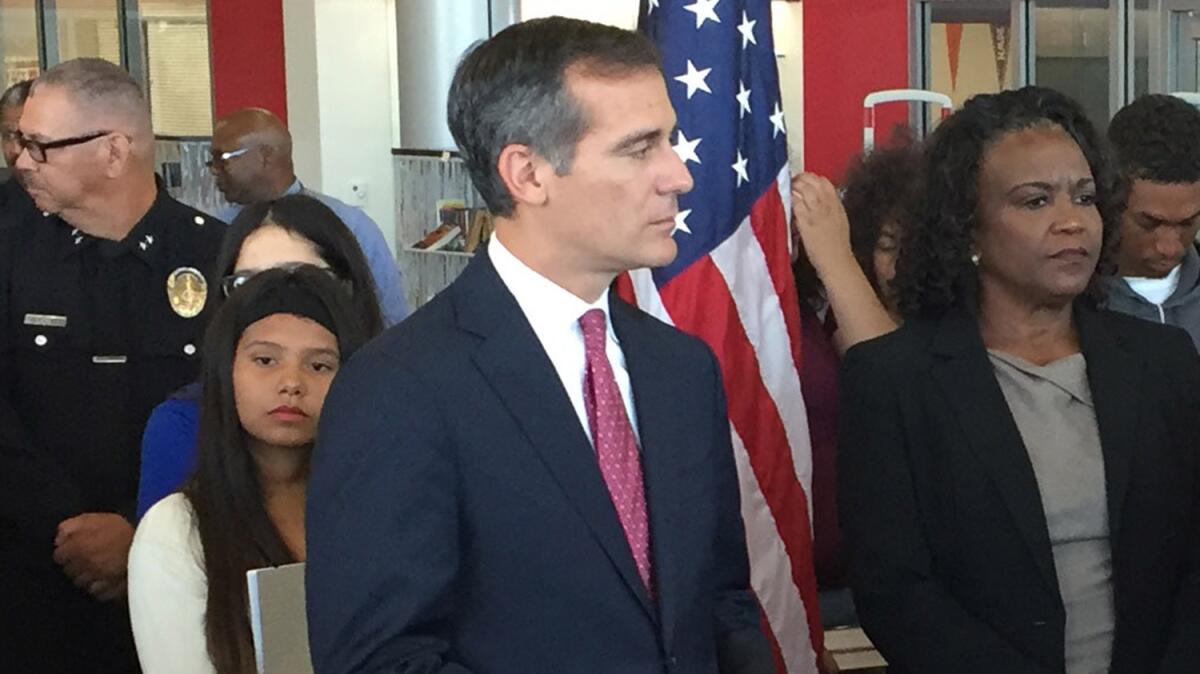
The big event for top local officials to mark the opening of school took place in the library of John C. Fremont High School, where L.A. Mayor Eric Garcetti renewed his pledge to provide one year of free community college to district graduates.
“For our seniors that are here today, this is our promise to you: When you graduate, community college will be free this next year,” he said.
Funding for this effort still is being developed. City officials hope to work with local community colleges to amass the necessary dollars, according to a Garcetti aide.
“One of the barriers that inhibits our kids’ ability to go to college is being removed,” said L.A. schools Supt. Michelle King. “We are telling our students: Work hard, graduate from high school…and then when you walk across that stage, there is a [college] seat waiting for you.”
The mayor also promised city library cards to 50,000 kindergartners this year.
Garcetti said he wanted these children to “become great utilizers of the most incredible assets that we have in the city.”
Again, King praised Garcetti’s efforts.
“Literacy is key for all of our kids — ensuring they’re able to read, to write and to listen,” King said. “Access to libraries is a key piece to ensuring that that happens. Our priority is for each and every L.A. Unified student to have a library card.”
The choice of Fremont was meant to highlight an ongoing $80 million campus facelift. The library and the cafeteria recently have been recently renovated, and more improvements are planned, including a greenhouse.
- Share via
L.A. Unified’s first all-girls STEM school gets a lively start

GALA is an all-girls school in the Los Angeles Unified School District.
The girls posed all over their new campus and clapped as they chanted about “leadership, wellness and honor.”
They’re students of the Girls Academic Leadership Academy, or GALA, a new all-girls school in L.A. GALA is focusing on Science, Science, Technology, Engineering and Mathematics, said principal Elizabeth Hicks, because some of those fields have far fewer women than men.
The curriculum will include hands-on work and projects, Hicks said, such as a flight simulator.
- Share via
Building better parent-teacher bonds
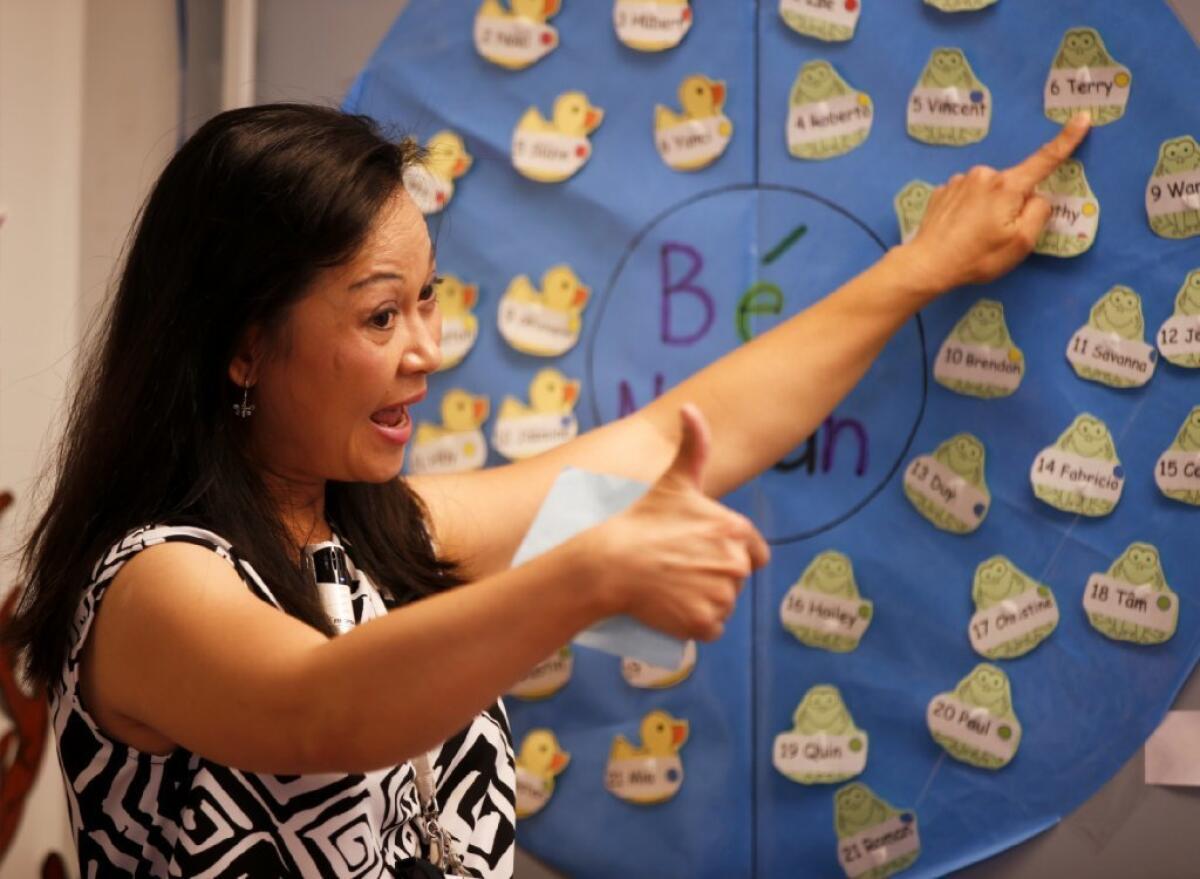
It’s never too early to think about creating productive working relationships with your child’s teachers. Why? Improving communication between teachers and parents can help create the best classroom experience and environment.
Some of the biggest obstacles in parent-teacher communication, a survey last year by leadership training company VitalSmarts found, were the lack of a relationship, shame about personal circumstance, a desire for privacy, scheduling challenges and a “what’s the point” sense of futility.
“The more the teachers understand the context of [children’s] behavior, the more successful they can be at their jobs.”
— David Maxfield, vice president of VitalSmarts
- Share via
Getting to Wilson High School’s new firefighter magnet in a fire engine
- Share via
Starting the school year with smiles
- Share via
Ready for all the homework?
One of the concerns that always seems to surface for parents around the start of the school year is homework: How much is too much?
L.A. Unified has suggested time allocations for students’ homework, and recommends assigning homework only four days a week. The guidelines, however, aren’t mandatory.
So what’s the point of homework? That all depends on what grade your child is in. The Times’ Sonali Kohli delves into the subject, discussing the role of homework, the “10-minute rule,” what a parent’s job is, where to get homework help and what to do if there’s too much homework.
Don’t fret. It’s normal to hate homework – whether you’re a student, parent or teacher. The key is to manage it and get the most out of the exercise.
- Share via
A parent’s guide to AP classes
Parents of high schoolers, you may be wondering what the difference is between the Advanced Placement classes and regular classes at your teen’s school.
Advanced Placement, or AP, classes are college-level courses taught in high school. The goal is to expose students to the rigorous standards they will face in college, to increase college preparedness and to challenge students beyond regular and often beyond honors courses.
“It’s at least 30% more [work] than another class,” said James Keipp, the director UCLA’s AP Readiness Program, which offers free support classes to LAUSD students.
Here’s what the experts told us.
(And if you have more questions, you can tweet them to us @LATEducation.)
- Share via
Back to school also means more cars on the streets
You woke up on Tuesday morning, ate breakfast and thought you would get to the office at the same time you did on Monday.
Then you got in your car, and, shocked by the gridlock, turned on the radio. Breaking news: It’s the first day of school in the Los Angeles Unified School District.
Time to head to Twitter to complain.
But is it real?
L.A. School Police Department Chief Steven Zipperman certainly thinks so.
We asked Juan Matute, a lecturer and the associate director of the UCLA Lewis Center and Institute of Transportation Studies.
While Matute said he hasn’t seen definitive research studying the effects of L.A. Unified’s first day on traffic, he estimates that there are probably “a percent or two more Angelenos on the road this week than there were last week.”
Why might the traffic feel worse than that? Some parents might be driving to new schools for the first time, likely taking the most congested routes. There’s research showing that adding a car to an already clogged pathway has a greater effect than it would on a street where traffic is moving, Matute said.
Plus, it’s still summer, so tourists are also on the road.
There’s hope. Matute said, because as the year progresses, parents figure out better, less congested routes. They also meet other parents and carpool, or their kids mature and they trust them to take the bus on their own -- resulting in fewer cars at rush hour.
- Share via
Worries and college t-shirts at Fourth Street Elementary School
This morning, parents and students streamed through the gates of Fourth Street Elementary School in East Los Angeles, a school the district chose to highlight on its back-to-school tour because its enrollment has gone up this year, bucking a district-wide trend.
Previously, the school was projected to lose 40 students this year — and that projection resulted in the loss of two teachers. But by Tuesday, principal Lupe Carrandi said she actually had 30 more students enrolled than last year.
Because the enrollment on the first day back beat the projection, Carrandi said she hopes she gets one of those teaching positions back. She attributes the uptick to rising test scores and increased outreach to parents, some of whom obtain permits to attend her school in lieu of their assigned one, she said.
“This is a school with a lot of history,” Carrandi said. “We have a good reputation in the community, and we’ve had increased test scores compared to other schools in the area.”
Ponytailed fifth-grader Mia Garcia arrived with her mother, Claudia, eager to meet her teacher.
“I like to learn math,” she said, pulling her mom toward the blacktop, where children gathered with their classmates. “If I want to work as a cashier some day, it’ll help.”
“I’m scaaaaared,” a girl wailed nearby.
“This school is one of the good ones,” said Alma Falcon, after snapping a picture of her third-grader, Daniel Faccuseh, in his Stanford t-shirt. Students had been instructed to wear their “college shirts” for the first day.
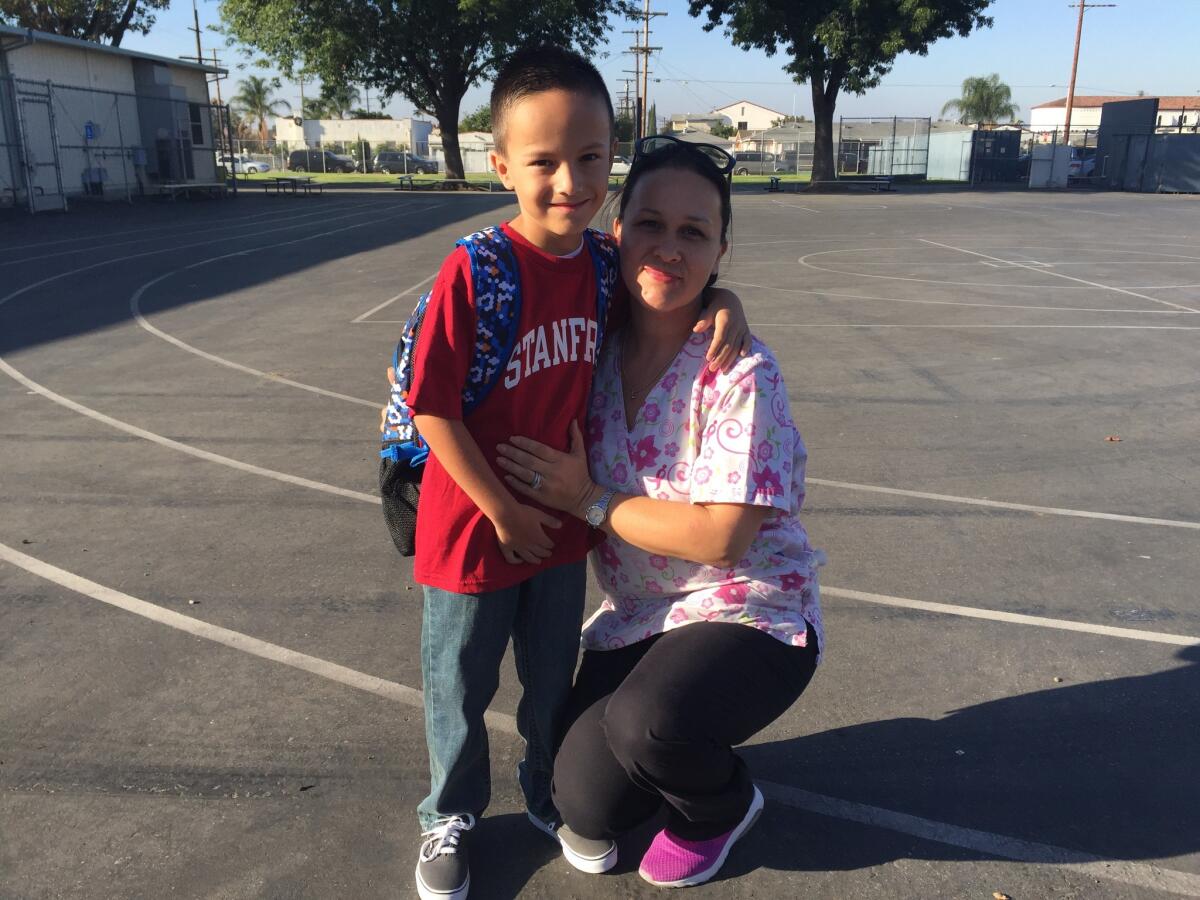
- Share via
Mayor Garcetti helps kick off the school year at John C. Fremont High
- Share via
That last second of summer
- Share via
L.A. Unified opens two firefighter magnet schools
A fire truck rolled through the gates of Banning High School at 8 a.m. Tuesday morning as the last of the school’s students grabbed their breakfasts -- but there wasn’t any emergency
Firefighters from Wilmington’s Fire Station 38 had come to give the students in the school’s new firefighter-themed magnet a chance to explore their truck.
Banning and Wilson high schools both opened firefighter magnets Tuesday — the first of their kind in the school system.
Banning’s magnet has 72 students enrolled, though only about 50 were present at PE class Tuesday morning.
“You are the future of our fire department,” L.A. Fire Capt. Eddie Marez, the fire department’s youth programs coordinator, told the students in the gym Tuesday morning.
One goal is to recruit more women into the department. There were about 15 girls in the group Tuesday morning.
“You don’t have to be a guy to run, and exercise, and ... be active and, you know, help people,” said Jessica Melgoza, 14, a ninth-grader in the new program.
- Share via
Familiar faces at a new school for girls
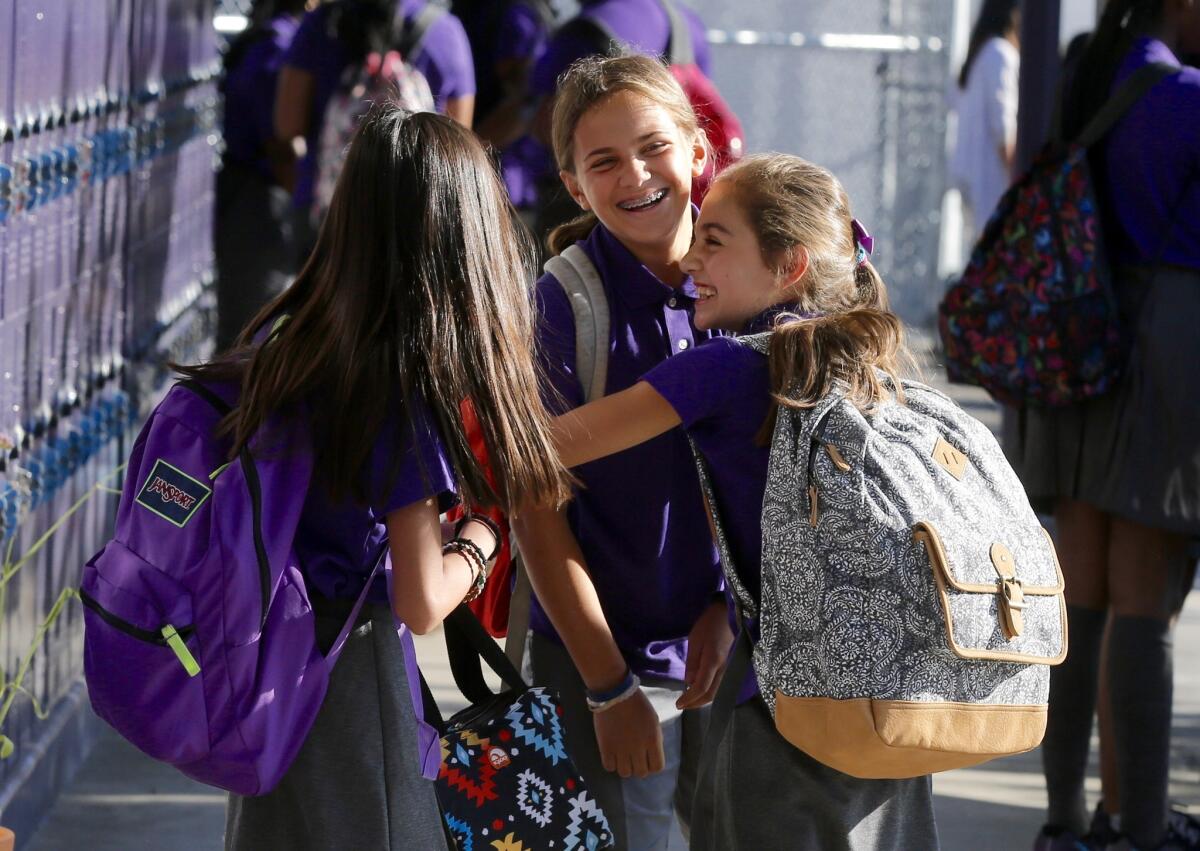
- Share via
Why is it important for girls to be firefighters?
- Share via
One dad’s hopes for his daughter’s school year
What do you hope for your child’s experience and what are your concerns as you send them on their way? We’ve invited parents on social media to share their own back-to-school thoughts.
Here’s what one dad told us:
We have no worries other than making sure she has the tools to process the challenges that come up. And trust that she develops the tools on her own for the situations we can’t prepare her for.
— Mike Bowers
We’d love to hear from you. Post your thoughts – and even a photo, if you’d like – about your back-to-school experience on Facebook. We hope to share some of them here throughout the day.
- Share via
Ready for class -- in a new all-girls school
- Share via
For some Westside little ones: kindergarten boot camp
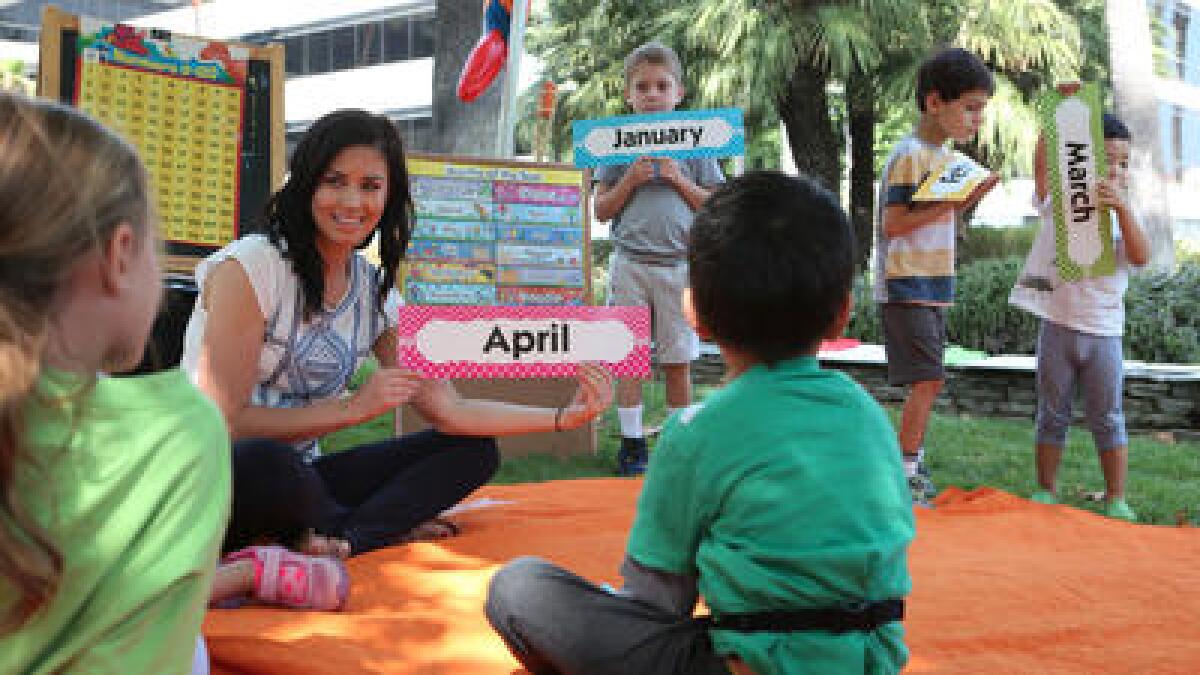
They could have been splashing in a pool or playing with their stuffed animals. But some local little ones had more serious work to do.
Their parents had signed them up for KinderPrep, a $1,000, weeklong boot camp designed to prepare them for the rigors of kindergarten.
In the Santa Monica program, kids go over such basics as the months of the year. They practice listening and following directions. They line up single file, for instance, to go get a snack.
As for that snack, think organic gummies and aloe water.
- Share via
Encouragement for L.A.’s future firefighters
- Share via
Welcome to Banning High. Have some breakfast.
- Share via
L.A. schools boast about rising graduation rates
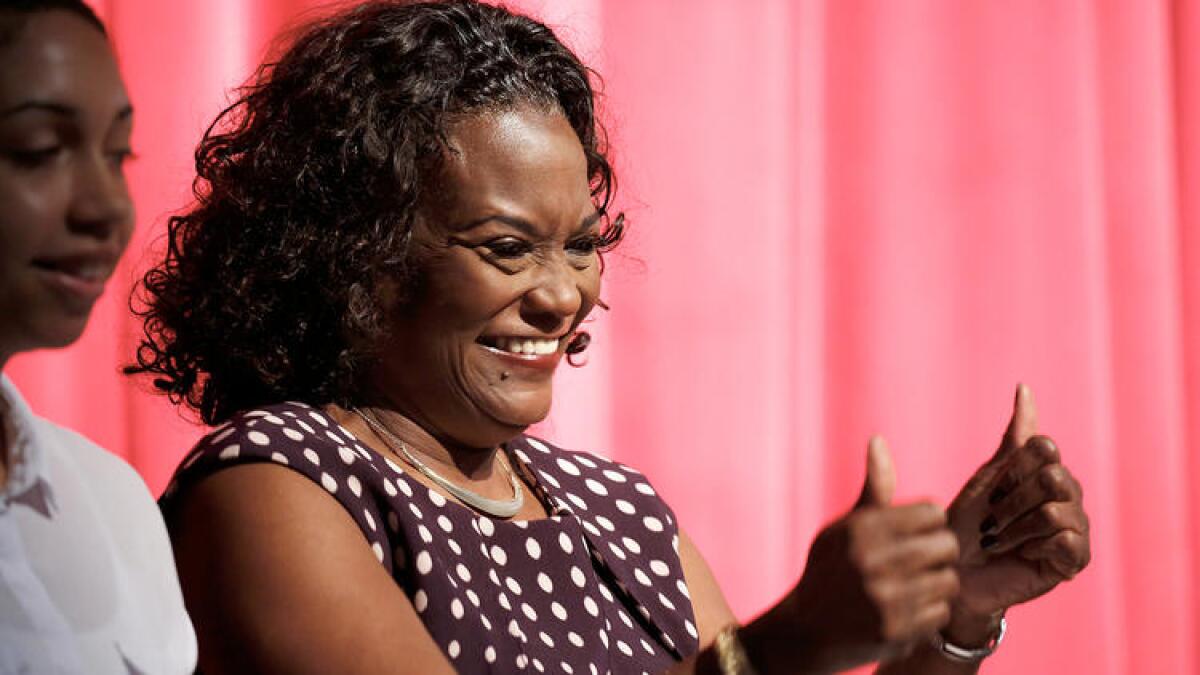
L.A. Unified Supt. Michelle King kicked off the new school year with some good news: The school system’s graduation rate had gone up.
In fact, she said at her first “state of the district” address, the district is projecting a 75% graduation rate for the 2015-16 school year -- the highest rate the nation’s second-largest school system has ever tabulated.
Not that everyone fully accepted that number. After all, in December, only about half of district seniors were on track to graduate. Some wonder about the real educational benefits of the district’s growing reliance on credit recovery.
- Share via
Join us as we cover the first day of school
- Share via
It’s August! Why is school starting so early?
Remember when just about every school started after Labor Day? No longer. These days, it’s the norm to get an early jump on the year.
L.A. Unified is hardly alone here. Some Southern California schools opened their doors last week.
The reasons for the early starts vary — from getting exams over before Christmas vacation to making sure students who need it get to summer school on time.
We asked local superintendents about the summer creep.
